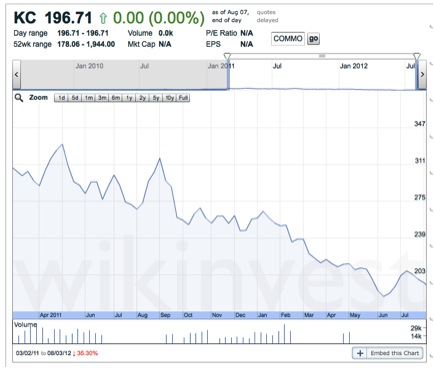We received our August, 2012 Stumptown new release samples today! But before we present them with our thoughts, I thought I might do something of a retrospective on Stumptown releases for as long as I have data: 7 releases between March 2011 thru August 2012. Note that the charts exclude Grand Cru and Decaf:
Release pricing over time is interesting, especially when compared to the spot price of Arabica coffee as traded on the NYMEX. As you can see below, the direction of prices per pound are opposites, with Stumptown increasing gradually from March 2011 thru August 2012 and the spot price of coffee falling over that same period. The opposite price trends highlight what Third Wave Coffee is all about, the decommoditization of the coffee. Stumptown Coffee is not just coffee as the price increases in a period of coffee prices declines demonstrates. We'll that's all for now.
How Better Coffee Tastes: Stumptown Latins Visualized
We love infographics/data-visualizations here at Joyrideas you might have noticed from past blog posts such as Coffee and the Economy, Tracking Caffeine with Style, and Coffee Export Data Visualization. And while we normally share work by others that we find interesting, from time to time, we roll up our sleeves, compile our own data sets, and generate our own visualizations, made possible by some very cool (and free) online resources, such as Many Eyes. Why data visualization, why infographics? Well, they say a picture is worth a thousand words, and an infographic is a picture on steroids! In particular we enjoy how data visualization affords us new perspectives on familiar facts and info. For example, today we decided to see if any trends emerge when we compile several flavor descriptions together and visualize them as a set. Specifically, we aggregated the flavor profile descriptions of Stumptown's 2012 Latin America offerings.
We collated the descriptions for all of Stumptown's current Latin offerings, removing articles, prepositions, pronouns, etc., to hone in on the adjectives, adverbs, and verbs. The infographic that follows spatially represents the frequency with which certain words are used. As the graphic indicates, the three most common flavors used to describe this year's Latin offerings are Caramel, Apple, and Chocolate:


It will be interesting to see how the Latins compare to the African descriptions or the Indonesian description. It would also be kind of cool to see how the popularity of specific words changes from year to year. After all, it was just two years ago that apparently everything tasted Meyer Lemons. Now that I can finally buy a Meyer Lemon at Fairway, it's use in coffee flavor profiling has all but disappeared.
Infographic - Coffee and the Economy
Cold Brew's a'Growin' Up; Ristretto: Kickstand Concentrate
Cold Brew's market evolution has been fast and furious. In his Ristretto column on July 27th, Oliver Strand turns his attention once again to this summer's darling, cold brew iced coffee. In an article/post entitled, Kickstand Concentrate,
Is Coffee's Third Wave Sustainable?
We’re all familiar by now with third-wave coffee not only as a concept, but also as a cup of coffee. We’ve tasted the difference, tasted a new kind of cup. Superior quality beans, sourced directly from individual farms are offered at prices within the reach of most and we’ve come to expect much more from our morning cup of joe than caffeine; we expect an experience.
Iced Coffee Market Heats Up
In a recent (07.05.11) New York Times article, "Iced Coffee Gets Its Day in the Sun", Andrew Newman draws our attention to the iced coffee slice of the coffee market.













